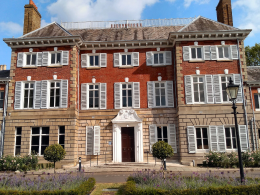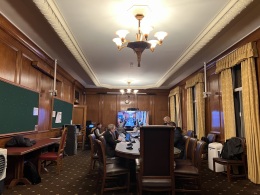Sarah Adams travelled from Kent to Wandsworth Town Hall on 17 November to defend the school she runs. Bradstow School serves 12 children with complex autism needs, and Wandsworth Council had decided to close it down.
Adams had three minutes to speak to the committee examining the decision. When councillors asked if she could answer their questions, the chair ruled it “way outside the remit.” A vote was held: three Labour councillors voted against allowing questions, two Conservative councillors voted in favour. Adams sat silent for the rest of the two-hour meeting while the committee voted 3-2 to uphold the closure anyway.
This was the first real test of Wandsworth’s new scrutiny system, introduced in March with promises of better accountability and more transparent decision-making. The result suggests the opposite has been achieved.
What happened
In March, Wandsworth Council changed how it checks controversial decisions. The old system – where committees reviewed decisions before they were made – was replaced with a new process that Council Leader Simon Hogg said would work “much more like parliamentary select committees” and allow scrutiny to “meaningfully influence proposals at a much earlier stage.”
The Bradstow closure was the first controversial decision to be examined under the new system. Our own investigation into the school closure had highlighted numerous discrepancies and concerns about how decisions were made, noting that “the whole narrative unravels” as soon as you scratch below the surface.
We concluded: “Everyone acted in institutional self-interest while claiming to act in children’s interests.”
Five opposition councillors agreed and formally called in the Cabinet’s decision to close the school, identifying eight serious concerns:
- Hidden correspondence: Letters between Wandsworth and the Department for Education weren’t included in the original decision papers. When disclosed after the call-in, they showed the DfE had asked for the closure to be paused until March 2026.
- Disputed debt: The council claims Kent County Council owes £4.6 million. Kent says there’s “no legal basis” for this claim. No evidence was provided to resolve this.
- Conflicting financial evidence: Opposition councillors presented evidence the school had cut its deficit from £1.2m to £600k and could be sustainable. This wasn’t meaningfully addressed.
- 48-hour ultimatum: The council gave the DfE 48 hours to commit £600,000 or closure would proceed. No explanation was given for this deadline.
- Missing impact assessment: No proper assessment of closing a specialist autism facility.
- Predetermined decision: A earlier council document had identified Bradstow for “disposal.” When raised, Cabinet Member Judi Gasser dismissed it as “an internal officer level and not even senior officer level document” despite it being an official council publication.
- Unknown pupil destinations: No clear plan for where the 12 children would go.
- Dismissed consultation: Parents and staff said consultation felt like “ticking boxes.”
The committee examined these concerns for over two hours. When asked about the DfE’s position, Cabinet Member Gasser said her understanding was her “inference from lack of warm words” – not based on clear communication. On the disputed £4.6m debt, no legal evidence was provided. The headteacher was blocked from answering questions.
The committee then voted. All three Labour councillors voted to uphold the closure. Both Conservative councillors voted to refer it back. The school closes December 31.
What changed and why it matters
The reforms made earlier this year made three key changes that affect all controversial council decisions:
1. Fewer decisions scrutinised in advance: The threshold for what counts as a “key decision” increased from £214,905 to £1 million – meaning 78% fewer decisions get advance scrutiny or appear on the public Forward Plan. Decisions between £214k-£1m are still published but don’t get the same oversight.
2. Post-decision scrutiny only: The old system reviewed Cabinet decisions before they were made. The new system reviews them after – but only if five councillors formally call in the decision within three working days, and only if they can prove “principles of decision making have not been followed” or the decision is “contrary to policy framework or budget.” It’s a high hurdle.
3. Single committee with ruling party majority: Multiple scrutiny committees were replaced with one General Overview and Scrutiny Committee (GOSC) for call-ins. It has five members: three from the ruling party (currently Labour), two opposition. Any controversial decision by the ruling party will be examined by a committee where they hold the majority.
Promises vs reality
Promised: Committees that work “much more like parliamentary select committees with the ability to control their work plans and agenda.”
Delivered: A committee that meets only when a call-in is triggered, with no work plan and a built-in majority for the ruling party. Real parliamentary select committees have cross-party chairs and genuine influence over outcomes.
Promised: “Meaningfully influence proposals at a much earlier stage.”
Delivered: The Bradstow decision was made in October, scrutinised in November, with a December 31 closure date. That’s not earlier-stage influence – it’s post-decision review after implementation has begun.
Promised: “Opening up the Council to more public scrutiny” and moving away from “eleventh-hour scrutiny.”
Delivered: Critical correspondence withheld from original papers. Stakeholders silenced from answering questions. Eight concerns unresolved. A system that examines decisions after they’re made instead of before.
The warning that came true
When these changes were debated in March, Conservative Councillor Peter Graham warned they were “a blatant power grab” and predicted that opposition councillors would “have to resort to rifling through papers in Richmond to find out what’s happening in our own borough.”
It seemed like exaggeration. But Wandsworth and Richmond councils share the same Chief Executive and senior staff. Richmond operates a committee system with cross-party representation and full transparency. Wandsworth’s new system is demonstrably less transparent – and councillors now do reference Richmond’s papers to see how proper scrutiny works.
Graham also listed 14 major changes that had never been properly consulted on. Most striking: the reforms themselves were approved by the Labour-only Executive on 3 March in what the transcript shows was approximately 24 seconds of “consideration” – no questions, no debate. Council Leader Hogg asked “Are there any comments or questions on the paper? If not, is that agreed? Wonderful.”
The most significant change to council governance in over 20 years was nodded through in under half a minute.
Why this matters to you
You might not care about Bradstow School. You might not follow council politics. But here’s why this matters:
Wandsworth Council makes hundreds of decisions affecting residents’ daily lives: planning applications, school places, waste collection, road repairs, park maintenance, library hours, social care, how your money is spent.
The system that checks those decisions just got weaker:
- 78% fewer decisions get advance scrutiny
- Scrutiny now happens after decisions are made, not before
- The committee that reviews controversial decisions has a built-in ruling party majority
- Higher bar to scrutinise anything in the first place
The first test of this new system examined a decision affecting 12 vulnerable children, involving a disputed £4.6 million debt claim and hidden government correspondence. Eight serious concerns were raised. Two hours of examination produced zero changes. A 3-2 party-line vote upheld the decision.
If the accountability system doesn’t provide accountability on that case – what decisions will it actually change?
Council Leader Hogg promised in March to “let the sunlight in.” Based on the first test, the curtains appear drawn tighter than ever.






